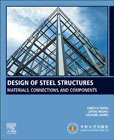
Design of Steel Structures: Materials, Connections, and Components
Zhou, Lingyu
Wang, Liping
Jiang, Liqiang
Design of Steel Structures: Materials, Connections, and Components systematically introduces the basic concepts and principles of the subject of Design of steel structure . This book contains 11 sections, including introduction; materials; failure modes of steel structures; members under tension, compression, bending and combined loads; steel connections, typical steel structural systems, composite members and vibrations resistance of steel members and connections. 1. General Introduction: not only the basic concept, development history and the general application of steel structures are introduced, but also the development status trend as well as the typical classifications of steel structures are specially described. 2. Materials of steel structures: different from other books, the materials of high-performance steel, cold-formed steel and other new types of steel are introduced and compared to the commonly used steel materials. 3. Possible failure modes of steel structures: the typical failure modes of steel structures are comprehensively introduced, including the instability failure, plastic collapse failure, fatigue failure, brittle fracture failure, cumulative damage failure due to cyclic loads, etc. Besides, some useful and commonly used methods are presented to prevent the failures of steel structures. 4. Members under tension and cables: both the concentrical the eccentrical tension loads are considered in this section, the effects of the bending moment is concluded in the design method according to the newest Chinese design code GB 50017-2017. 5. Members under axial compression: the typical total buckling modes of different sections are briefly introduced using the Structural Stability Theory; the 4 column curves are presented for determining the stability coefficient of different kinds of compression members; the limit values on height-to-thickness ratio and width-to-thickness ratio are introduced for preventing local buckling of flange and web of compression members; the equally strong design philosophy is introduced to design the section to different axis of compression members. 6. Members under bending: the equivalent moment coefficient is used to consider the ultimate load-carrying capacity of bending members with different boundary conditions and moment distributions; the design method of members subjected to local compression force is included in this book according to GB 50017-2017; besides, some case studies are presented for designing bending members in buildings and bridges; several practical methods that avoiding instability of bending members are introduced. 7. Members under combined tension-bending and combined compression-bending: the ultimate load-carrying capacity of members could be changed due to the combined loads, the correlation calculation formula is introduced for determining the capacities of the members subjected to combined loads; the tension-dominated, compression-dominated and bend-dominated loading conditions are individually introduced, and case studies are used to present the calculating method of those load-combined members. 8. Connections in steel structures: connection is the key technology for steel structures, a comprehensive introduction is made for different kinds of connections in beam-column joints, column-column joints and column bases; some new fabricated connecting methods as well as design methods are also included in this section. 9. Trusses, single storey steel frames, and arches: some commonly used steel structural systems are introduced in this book, the design procedures as well as the calculating methods are introduced in detail; some case studies are presented for designing these steel structures. 10. Composite members: in addition to the steel members, some commonly used steel-concrete composite members are also included in this book, including steel-concrete composite floor slabs, composite beams, composite columns, etc; a detailed introduction on calculating methods is made for these composite members. 11. Vibration resistance of steel structural members and connections: different from other books, the effects of dynamic loads on design of steel structures are considered; the hysteretic performance of steel members and joints under different loading conditions is introduced. Contains comprehensive basic knowledge for designing steel structures Introduces materials, connections, components, structural systems of steel structures. Both the theoretical calculating methods and the engineering design methods are comprehensively described A large number of engineering cases are introduced in this book, including new steel materials, new steel connections, new steel components and new construction technologies. Thus it is appropriate for potential readers from universities, designing institutes, construction companies, etc. INDICE: 1. General Introduction 2. Materials of steel structures 3. Possible failure modes of steel structures 4. Members under tension and cables 5. Members under axial compression 6. Members under bending 7. Members under combined tension-bending and combined compression-bending 8. Connections in steel structures 9. Trusses, single storey steel frames, and arches 10. Composite members 11. Vibration resistance of steel structural members and connections Appendix 1. Chemical composition and mechanical properties of major steel brands for steel structures 2. Properties of welding materials and design strength of steel, welds, and bolted connections 3. Property tables for commonly used steel and cross-sections of steel sections 4. Stability coefficients of axial compression members 5. Effective length coefficients of columns 6. Calculation charts
- ISBN: 978-0-323-91682-0
- Editorial: Elsevier
- Encuadernacion: Rústica
- Páginas: 260
- Fecha Publicación: 01/08/2022
- Nº Volúmenes: 1
- Idioma: Inglés
